Analyzing Uber's Digital Disruption Strategies in the UK Taxi Market
VerifiedAdded on 2023/06/11
|10
|3100
|218
Project
AI Summary
This research project delves into the impact of digital disruption on the taxi industry, with a specific focus on Uber. The project begins with an introduction outlining the rationale, research questions, aim, and objectives, setting the stage for an in-depth analysis. Chapter 2 presents a comprehensive literature review, exploring the concept of digital disruption across various industries, examining Uber's business model and its disruptive influence on the UK taxi market, and identifying the strategies Uber employs to maintain its competitive edge. The research aims to understand how Uber leverages digital technologies to disrupt the market and offers recommendations for future strategies. The project highlights the importance of adapting to new technologies and business models in the digital era, emphasizing the challenges and opportunities that arise from digital disruption. The project analyzes various business models used by Uber, including mobile application usage, fare splitting, subscription models, and freemium models, to understand how they contribute to its success. The project also explores the significance of digital disruption, the strategies used, and the models implemented by Uber to maintain its position in the market. This research project provides valuable insights into the dynamic interplay between technology and business.
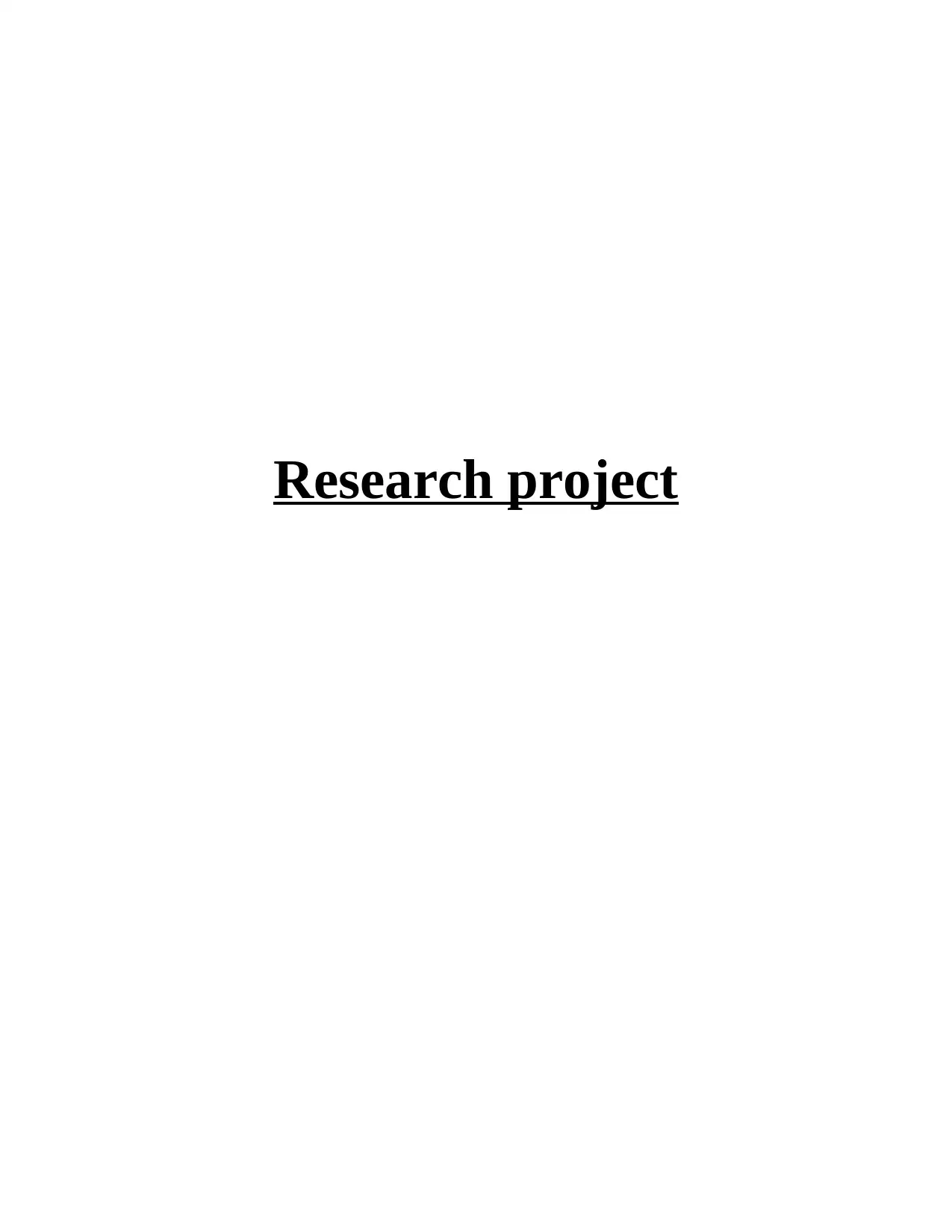
Research project
Paraphrase This Document
Need a fresh take? Get an instant paraphrase of this document with our AI Paraphraser
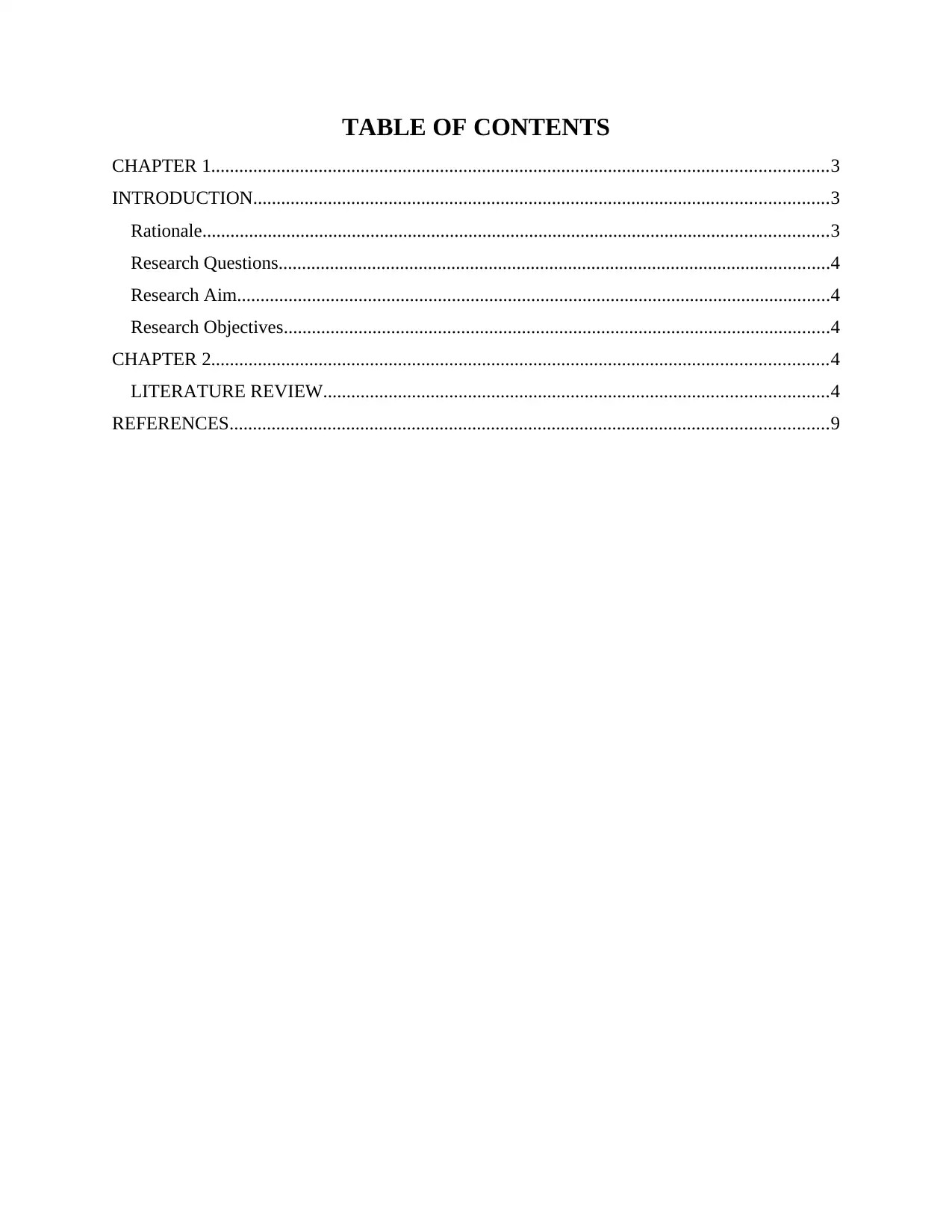
TABLE OF CONTENTS
CHAPTER 1....................................................................................................................................3
INTRODUCTION...........................................................................................................................3
Rationale......................................................................................................................................3
Research Questions......................................................................................................................4
Research Aim...............................................................................................................................4
Research Objectives.....................................................................................................................4
CHAPTER 2....................................................................................................................................4
LITERATURE REVIEW............................................................................................................4
REFERENCES................................................................................................................................9
CHAPTER 1....................................................................................................................................3
INTRODUCTION...........................................................................................................................3
Rationale......................................................................................................................................3
Research Questions......................................................................................................................4
Research Aim...............................................................................................................................4
Research Objectives.....................................................................................................................4
CHAPTER 2....................................................................................................................................4
LITERATURE REVIEW............................................................................................................4
REFERENCES................................................................................................................................9
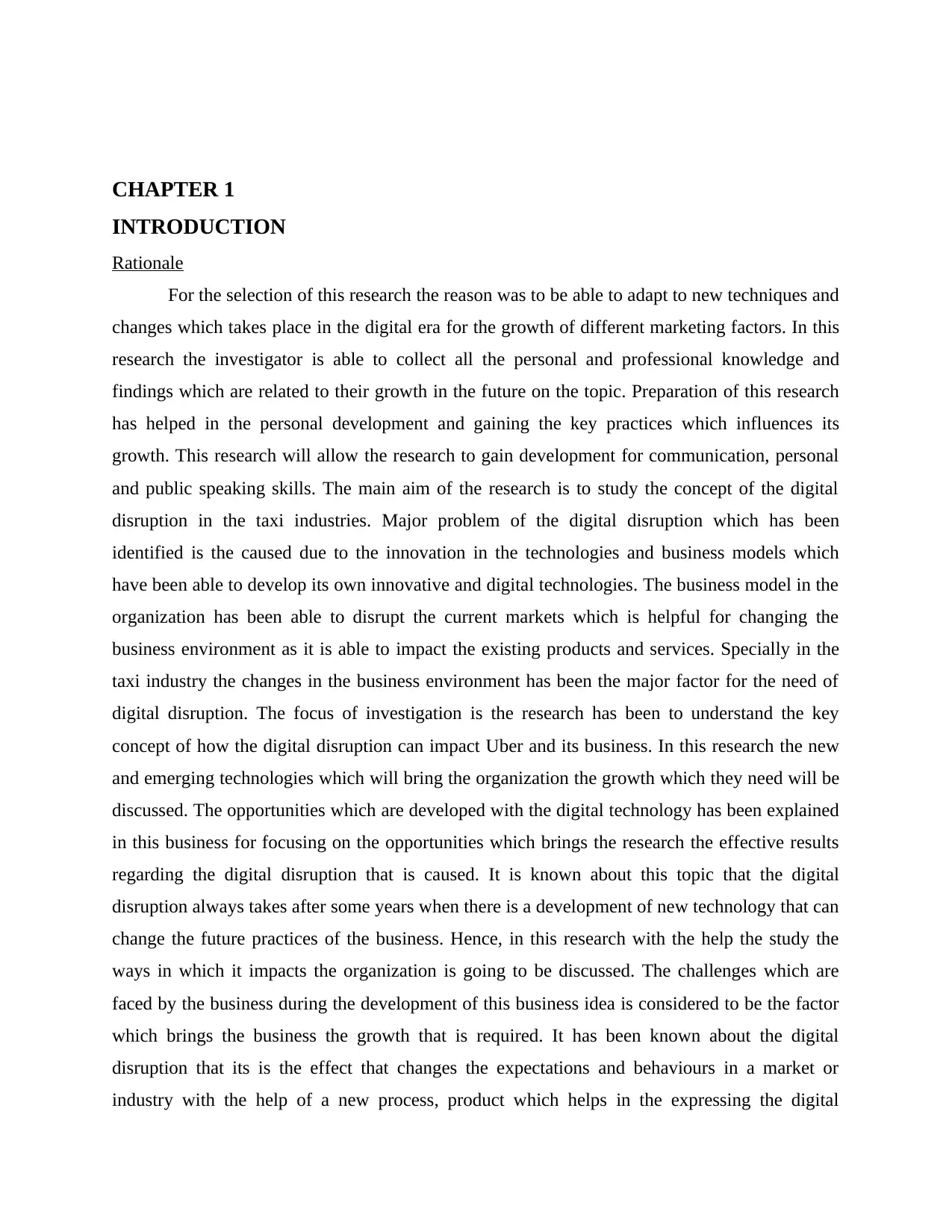
CHAPTER 1
INTRODUCTION
Rationale
For the selection of this research the reason was to be able to adapt to new techniques and
changes which takes place in the digital era for the growth of different marketing factors. In this
research the investigator is able to collect all the personal and professional knowledge and
findings which are related to their growth in the future on the topic. Preparation of this research
has helped in the personal development and gaining the key practices which influences its
growth. This research will allow the research to gain development for communication, personal
and public speaking skills. The main aim of the research is to study the concept of the digital
disruption in the taxi industries. Major problem of the digital disruption which has been
identified is the caused due to the innovation in the technologies and business models which
have been able to develop its own innovative and digital technologies. The business model in the
organization has been able to disrupt the current markets which is helpful for changing the
business environment as it is able to impact the existing products and services. Specially in the
taxi industry the changes in the business environment has been the major factor for the need of
digital disruption. The focus of investigation is the research has been to understand the key
concept of how the digital disruption can impact Uber and its business. In this research the new
and emerging technologies which will bring the organization the growth which they need will be
discussed. The opportunities which are developed with the digital technology has been explained
in this business for focusing on the opportunities which brings the research the effective results
regarding the digital disruption that is caused. It is known about this topic that the digital
disruption always takes after some years when there is a development of new technology that can
change the future practices of the business. Hence, in this research with the help the study the
ways in which it impacts the organization is going to be discussed. The challenges which are
faced by the business during the development of this business idea is considered to be the factor
which brings the business the growth that is required. It has been known about the digital
disruption that its is the effect that changes the expectations and behaviours in a market or
industry with the help of a new process, product which helps in the expressing the digital
INTRODUCTION
Rationale
For the selection of this research the reason was to be able to adapt to new techniques and
changes which takes place in the digital era for the growth of different marketing factors. In this
research the investigator is able to collect all the personal and professional knowledge and
findings which are related to their growth in the future on the topic. Preparation of this research
has helped in the personal development and gaining the key practices which influences its
growth. This research will allow the research to gain development for communication, personal
and public speaking skills. The main aim of the research is to study the concept of the digital
disruption in the taxi industries. Major problem of the digital disruption which has been
identified is the caused due to the innovation in the technologies and business models which
have been able to develop its own innovative and digital technologies. The business model in the
organization has been able to disrupt the current markets which is helpful for changing the
business environment as it is able to impact the existing products and services. Specially in the
taxi industry the changes in the business environment has been the major factor for the need of
digital disruption. The focus of investigation is the research has been to understand the key
concept of how the digital disruption can impact Uber and its business. In this research the new
and emerging technologies which will bring the organization the growth which they need will be
discussed. The opportunities which are developed with the digital technology has been explained
in this business for focusing on the opportunities which brings the research the effective results
regarding the digital disruption that is caused. It is known about this topic that the digital
disruption always takes after some years when there is a development of new technology that can
change the future practices of the business. Hence, in this research with the help the study the
ways in which it impacts the organization is going to be discussed. The challenges which are
faced by the business during the development of this business idea is considered to be the factor
which brings the business the growth that is required. It has been known about the digital
disruption that its is the effect that changes the expectations and behaviours in a market or
industry with the help of a new process, product which helps in the expressing the digital
⊘ This is a preview!⊘
Do you want full access?
Subscribe today to unlock all pages.

Trusted by 1+ million students worldwide
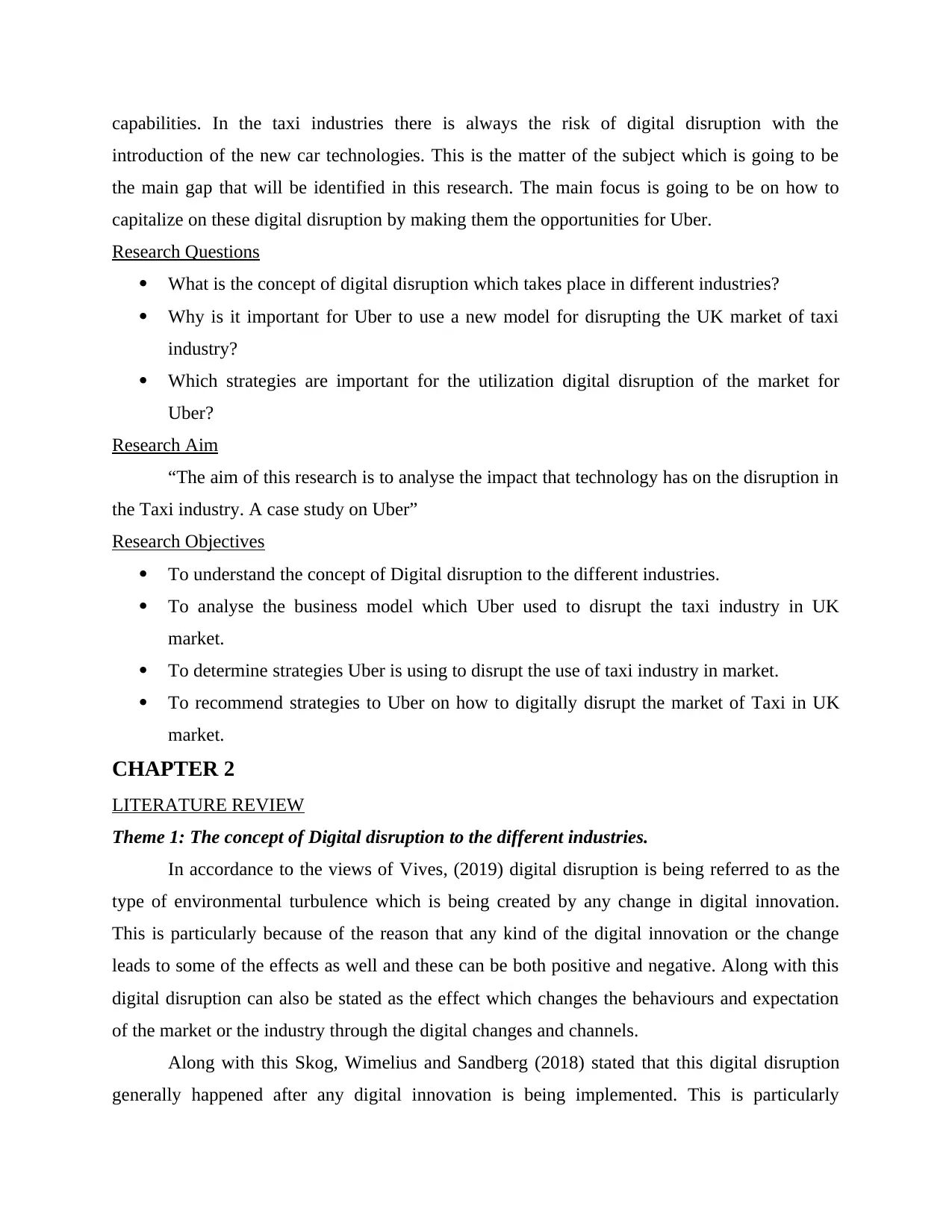
capabilities. In the taxi industries there is always the risk of digital disruption with the
introduction of the new car technologies. This is the matter of the subject which is going to be
the main gap that will be identified in this research. The main focus is going to be on how to
capitalize on these digital disruption by making them the opportunities for Uber.
Research Questions
What is the concept of digital disruption which takes place in different industries?
Why is it important for Uber to use a new model for disrupting the UK market of taxi
industry?
Which strategies are important for the utilization digital disruption of the market for
Uber?
Research Aim
“The aim of this research is to analyse the impact that technology has on the disruption in
the Taxi industry. A case study on Uber”
Research Objectives
To understand the concept of Digital disruption to the different industries.
To analyse the business model which Uber used to disrupt the taxi industry in UK
market.
To determine strategies Uber is using to disrupt the use of taxi industry in market.
To recommend strategies to Uber on how to digitally disrupt the market of Taxi in UK
market.
CHAPTER 2
LITERATURE REVIEW
Theme 1: The concept of Digital disruption to the different industries.
In accordance to the views of Vives, (2019) digital disruption is being referred to as the
type of environmental turbulence which is being created by any change in digital innovation.
This is particularly because of the reason that any kind of the digital innovation or the change
leads to some of the effects as well and these can be both positive and negative. Along with this
digital disruption can also be stated as the effect which changes the behaviours and expectation
of the market or the industry through the digital changes and channels.
Along with this Skog, Wimelius and Sandberg (2018) stated that this digital disruption
generally happened after any digital innovation is being implemented. This is particularly
introduction of the new car technologies. This is the matter of the subject which is going to be
the main gap that will be identified in this research. The main focus is going to be on how to
capitalize on these digital disruption by making them the opportunities for Uber.
Research Questions
What is the concept of digital disruption which takes place in different industries?
Why is it important for Uber to use a new model for disrupting the UK market of taxi
industry?
Which strategies are important for the utilization digital disruption of the market for
Uber?
Research Aim
“The aim of this research is to analyse the impact that technology has on the disruption in
the Taxi industry. A case study on Uber”
Research Objectives
To understand the concept of Digital disruption to the different industries.
To analyse the business model which Uber used to disrupt the taxi industry in UK
market.
To determine strategies Uber is using to disrupt the use of taxi industry in market.
To recommend strategies to Uber on how to digitally disrupt the market of Taxi in UK
market.
CHAPTER 2
LITERATURE REVIEW
Theme 1: The concept of Digital disruption to the different industries.
In accordance to the views of Vives, (2019) digital disruption is being referred to as the
type of environmental turbulence which is being created by any change in digital innovation.
This is particularly because of the reason that any kind of the digital innovation or the change
leads to some of the effects as well and these can be both positive and negative. Along with this
digital disruption can also be stated as the effect which changes the behaviours and expectation
of the market or the industry through the digital changes and channels.
Along with this Skog, Wimelius and Sandberg (2018) stated that this digital disruption
generally happened after any digital innovation is being implemented. This is particularly
Paraphrase This Document
Need a fresh take? Get an instant paraphrase of this document with our AI Paraphraser
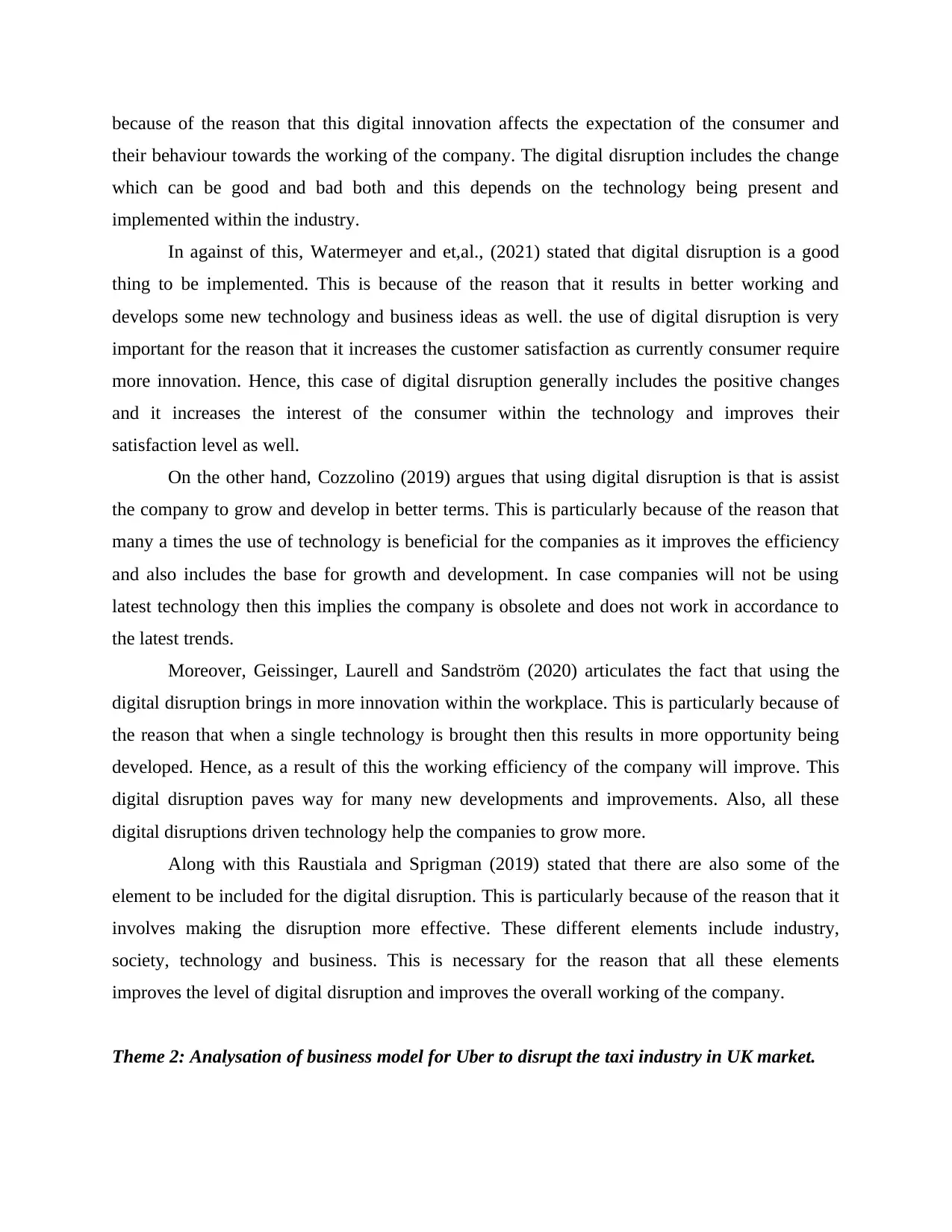
because of the reason that this digital innovation affects the expectation of the consumer and
their behaviour towards the working of the company. The digital disruption includes the change
which can be good and bad both and this depends on the technology being present and
implemented within the industry.
In against of this, Watermeyer and et,al., (2021) stated that digital disruption is a good
thing to be implemented. This is because of the reason that it results in better working and
develops some new technology and business ideas as well. the use of digital disruption is very
important for the reason that it increases the customer satisfaction as currently consumer require
more innovation. Hence, this case of digital disruption generally includes the positive changes
and it increases the interest of the consumer within the technology and improves their
satisfaction level as well.
On the other hand, Cozzolino (2019) argues that using digital disruption is that is assist
the company to grow and develop in better terms. This is particularly because of the reason that
many a times the use of technology is beneficial for the companies as it improves the efficiency
and also includes the base for growth and development. In case companies will not be using
latest technology then this implies the company is obsolete and does not work in accordance to
the latest trends.
Moreover, Geissinger, Laurell and Sandström (2020) articulates the fact that using the
digital disruption brings in more innovation within the workplace. This is particularly because of
the reason that when a single technology is brought then this results in more opportunity being
developed. Hence, as a result of this the working efficiency of the company will improve. This
digital disruption paves way for many new developments and improvements. Also, all these
digital disruptions driven technology help the companies to grow more.
Along with this Raustiala and Sprigman (2019) stated that there are also some of the
element to be included for the digital disruption. This is particularly because of the reason that it
involves making the disruption more effective. These different elements include industry,
society, technology and business. This is necessary for the reason that all these elements
improves the level of digital disruption and improves the overall working of the company.
Theme 2: Analysation of business model for Uber to disrupt the taxi industry in UK market.
their behaviour towards the working of the company. The digital disruption includes the change
which can be good and bad both and this depends on the technology being present and
implemented within the industry.
In against of this, Watermeyer and et,al., (2021) stated that digital disruption is a good
thing to be implemented. This is because of the reason that it results in better working and
develops some new technology and business ideas as well. the use of digital disruption is very
important for the reason that it increases the customer satisfaction as currently consumer require
more innovation. Hence, this case of digital disruption generally includes the positive changes
and it increases the interest of the consumer within the technology and improves their
satisfaction level as well.
On the other hand, Cozzolino (2019) argues that using digital disruption is that is assist
the company to grow and develop in better terms. This is particularly because of the reason that
many a times the use of technology is beneficial for the companies as it improves the efficiency
and also includes the base for growth and development. In case companies will not be using
latest technology then this implies the company is obsolete and does not work in accordance to
the latest trends.
Moreover, Geissinger, Laurell and Sandström (2020) articulates the fact that using the
digital disruption brings in more innovation within the workplace. This is particularly because of
the reason that when a single technology is brought then this results in more opportunity being
developed. Hence, as a result of this the working efficiency of the company will improve. This
digital disruption paves way for many new developments and improvements. Also, all these
digital disruptions driven technology help the companies to grow more.
Along with this Raustiala and Sprigman (2019) stated that there are also some of the
element to be included for the digital disruption. This is particularly because of the reason that it
involves making the disruption more effective. These different elements include industry,
society, technology and business. This is necessary for the reason that all these elements
improves the level of digital disruption and improves the overall working of the company.
Theme 2: Analysation of business model for Uber to disrupt the taxi industry in UK market.
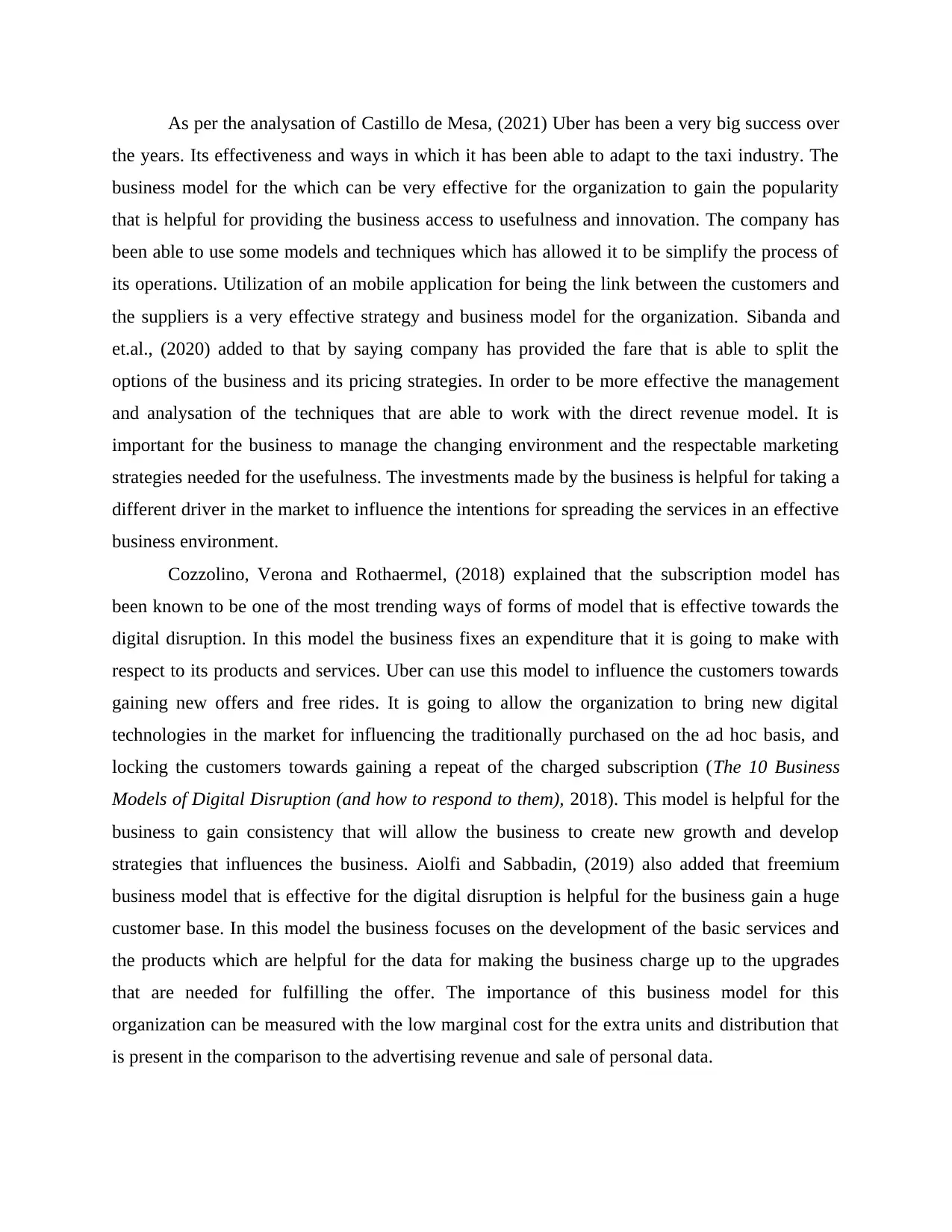
As per the analysation of Castillo de Mesa, (2021) Uber has been a very big success over
the years. Its effectiveness and ways in which it has been able to adapt to the taxi industry. The
business model for the which can be very effective for the organization to gain the popularity
that is helpful for providing the business access to usefulness and innovation. The company has
been able to use some models and techniques which has allowed it to be simplify the process of
its operations. Utilization of an mobile application for being the link between the customers and
the suppliers is a very effective strategy and business model for the organization. Sibanda and
et.al., (2020) added to that by saying company has provided the fare that is able to split the
options of the business and its pricing strategies. In order to be more effective the management
and analysation of the techniques that are able to work with the direct revenue model. It is
important for the business to manage the changing environment and the respectable marketing
strategies needed for the usefulness. The investments made by the business is helpful for taking a
different driver in the market to influence the intentions for spreading the services in an effective
business environment.
Cozzolino, Verona and Rothaermel, (2018) explained that the subscription model has
been known to be one of the most trending ways of forms of model that is effective towards the
digital disruption. In this model the business fixes an expenditure that it is going to make with
respect to its products and services. Uber can use this model to influence the customers towards
gaining new offers and free rides. It is going to allow the organization to bring new digital
technologies in the market for influencing the traditionally purchased on the ad hoc basis, and
locking the customers towards gaining a repeat of the charged subscription (The 10 Business
Models of Digital Disruption (and how to respond to them), 2018). This model is helpful for the
business to gain consistency that will allow the business to create new growth and develop
strategies that influences the business. Aiolfi and Sabbadin, (2019) also added that freemium
business model that is effective for the digital disruption is helpful for the business gain a huge
customer base. In this model the business focuses on the development of the basic services and
the products which are helpful for the data for making the business charge up to the upgrades
that are needed for fulfilling the offer. The importance of this business model for this
organization can be measured with the low marginal cost for the extra units and distribution that
is present in the comparison to the advertising revenue and sale of personal data.
the years. Its effectiveness and ways in which it has been able to adapt to the taxi industry. The
business model for the which can be very effective for the organization to gain the popularity
that is helpful for providing the business access to usefulness and innovation. The company has
been able to use some models and techniques which has allowed it to be simplify the process of
its operations. Utilization of an mobile application for being the link between the customers and
the suppliers is a very effective strategy and business model for the organization. Sibanda and
et.al., (2020) added to that by saying company has provided the fare that is able to split the
options of the business and its pricing strategies. In order to be more effective the management
and analysation of the techniques that are able to work with the direct revenue model. It is
important for the business to manage the changing environment and the respectable marketing
strategies needed for the usefulness. The investments made by the business is helpful for taking a
different driver in the market to influence the intentions for spreading the services in an effective
business environment.
Cozzolino, Verona and Rothaermel, (2018) explained that the subscription model has
been known to be one of the most trending ways of forms of model that is effective towards the
digital disruption. In this model the business fixes an expenditure that it is going to make with
respect to its products and services. Uber can use this model to influence the customers towards
gaining new offers and free rides. It is going to allow the organization to bring new digital
technologies in the market for influencing the traditionally purchased on the ad hoc basis, and
locking the customers towards gaining a repeat of the charged subscription (The 10 Business
Models of Digital Disruption (and how to respond to them), 2018). This model is helpful for the
business to gain consistency that will allow the business to create new growth and develop
strategies that influences the business. Aiolfi and Sabbadin, (2019) also added that freemium
business model that is effective for the digital disruption is helpful for the business gain a huge
customer base. In this model the business focuses on the development of the basic services and
the products which are helpful for the data for making the business charge up to the upgrades
that are needed for fulfilling the offer. The importance of this business model for this
organization can be measured with the low marginal cost for the extra units and distribution that
is present in the comparison to the advertising revenue and sale of personal data.
⊘ This is a preview!⊘
Do you want full access?
Subscribe today to unlock all pages.

Trusted by 1+ million students worldwide
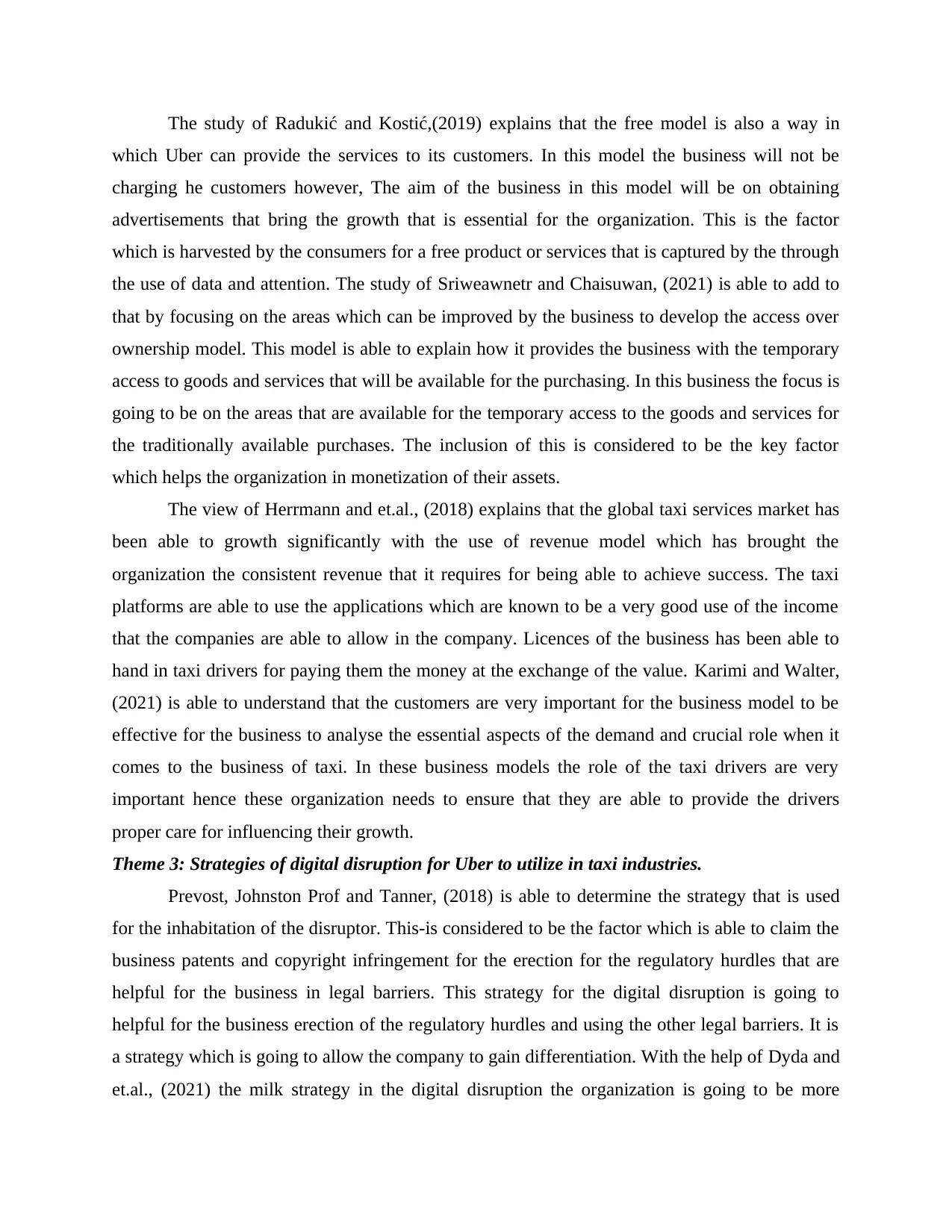
The study of Radukić and Kostić,(2019) explains that the free model is also a way in
which Uber can provide the services to its customers. In this model the business will not be
charging he customers however, The aim of the business in this model will be on obtaining
advertisements that bring the growth that is essential for the organization. This is the factor
which is harvested by the consumers for a free product or services that is captured by the through
the use of data and attention. The study of Sriweawnetr and Chaisuwan, (2021) is able to add to
that by focusing on the areas which can be improved by the business to develop the access over
ownership model. This model is able to explain how it provides the business with the temporary
access to goods and services that will be available for the purchasing. In this business the focus is
going to be on the areas that are available for the temporary access to the goods and services for
the traditionally available purchases. The inclusion of this is considered to be the key factor
which helps the organization in monetization of their assets.
The view of Herrmann and et.al., (2018) explains that the global taxi services market has
been able to growth significantly with the use of revenue model which has brought the
organization the consistent revenue that it requires for being able to achieve success. The taxi
platforms are able to use the applications which are known to be a very good use of the income
that the companies are able to allow in the company. Licences of the business has been able to
hand in taxi drivers for paying them the money at the exchange of the value. Karimi and Walter,
(2021) is able to understand that the customers are very important for the business model to be
effective for the business to analyse the essential aspects of the demand and crucial role when it
comes to the business of taxi. In these business models the role of the taxi drivers are very
important hence these organization needs to ensure that they are able to provide the drivers
proper care for influencing their growth.
Theme 3: Strategies of digital disruption for Uber to utilize in taxi industries.
Prevost, Johnston Prof and Tanner, (2018) is able to determine the strategy that is used
for the inhabitation of the disruptor. This-is considered to be the factor which is able to claim the
business patents and copyright infringement for the erection for the regulatory hurdles that are
helpful for the business in legal barriers. This strategy for the digital disruption is going to
helpful for the business erection of the regulatory hurdles and using the other legal barriers. It is
a strategy which is going to allow the company to gain differentiation. With the help of Dyda and
et.al., (2021) the milk strategy in the digital disruption the organization is going to be more
which Uber can provide the services to its customers. In this model the business will not be
charging he customers however, The aim of the business in this model will be on obtaining
advertisements that bring the growth that is essential for the organization. This is the factor
which is harvested by the consumers for a free product or services that is captured by the through
the use of data and attention. The study of Sriweawnetr and Chaisuwan, (2021) is able to add to
that by focusing on the areas which can be improved by the business to develop the access over
ownership model. This model is able to explain how it provides the business with the temporary
access to goods and services that will be available for the purchasing. In this business the focus is
going to be on the areas that are available for the temporary access to the goods and services for
the traditionally available purchases. The inclusion of this is considered to be the key factor
which helps the organization in monetization of their assets.
The view of Herrmann and et.al., (2018) explains that the global taxi services market has
been able to growth significantly with the use of revenue model which has brought the
organization the consistent revenue that it requires for being able to achieve success. The taxi
platforms are able to use the applications which are known to be a very good use of the income
that the companies are able to allow in the company. Licences of the business has been able to
hand in taxi drivers for paying them the money at the exchange of the value. Karimi and Walter,
(2021) is able to understand that the customers are very important for the business model to be
effective for the business to analyse the essential aspects of the demand and crucial role when it
comes to the business of taxi. In these business models the role of the taxi drivers are very
important hence these organization needs to ensure that they are able to provide the drivers
proper care for influencing their growth.
Theme 3: Strategies of digital disruption for Uber to utilize in taxi industries.
Prevost, Johnston Prof and Tanner, (2018) is able to determine the strategy that is used
for the inhabitation of the disruptor. This-is considered to be the factor which is able to claim the
business patents and copyright infringement for the erection for the regulatory hurdles that are
helpful for the business in legal barriers. This strategy for the digital disruption is going to
helpful for the business erection of the regulatory hurdles and using the other legal barriers. It is
a strategy which is going to allow the company to gain differentiation. With the help of Dyda and
et.al., (2021) the milk strategy in the digital disruption the organization is going to be more
Paraphrase This Document
Need a fresh take? Get an instant paraphrase of this document with our AI Paraphraser
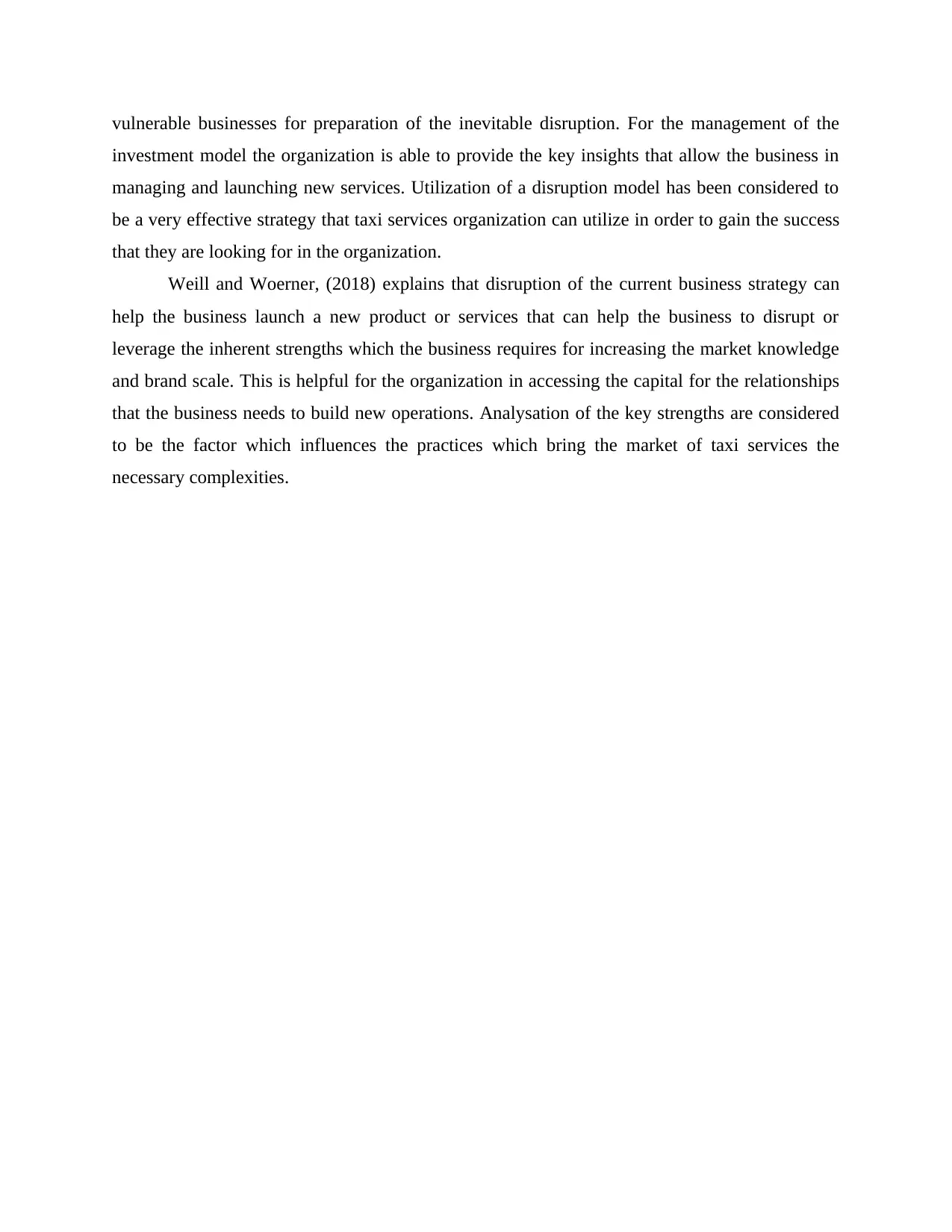
vulnerable businesses for preparation of the inevitable disruption. For the management of the
investment model the organization is able to provide the key insights that allow the business in
managing and launching new services. Utilization of a disruption model has been considered to
be a very effective strategy that taxi services organization can utilize in order to gain the success
that they are looking for in the organization.
Weill and Woerner, (2018) explains that disruption of the current business strategy can
help the business launch a new product or services that can help the business to disrupt or
leverage the inherent strengths which the business requires for increasing the market knowledge
and brand scale. This is helpful for the organization in accessing the capital for the relationships
that the business needs to build new operations. Analysation of the key strengths are considered
to be the factor which influences the practices which bring the market of taxi services the
necessary complexities.
investment model the organization is able to provide the key insights that allow the business in
managing and launching new services. Utilization of a disruption model has been considered to
be a very effective strategy that taxi services organization can utilize in order to gain the success
that they are looking for in the organization.
Weill and Woerner, (2018) explains that disruption of the current business strategy can
help the business launch a new product or services that can help the business to disrupt or
leverage the inherent strengths which the business requires for increasing the market knowledge
and brand scale. This is helpful for the organization in accessing the capital for the relationships
that the business needs to build new operations. Analysation of the key strengths are considered
to be the factor which influences the practices which bring the market of taxi services the
necessary complexities.
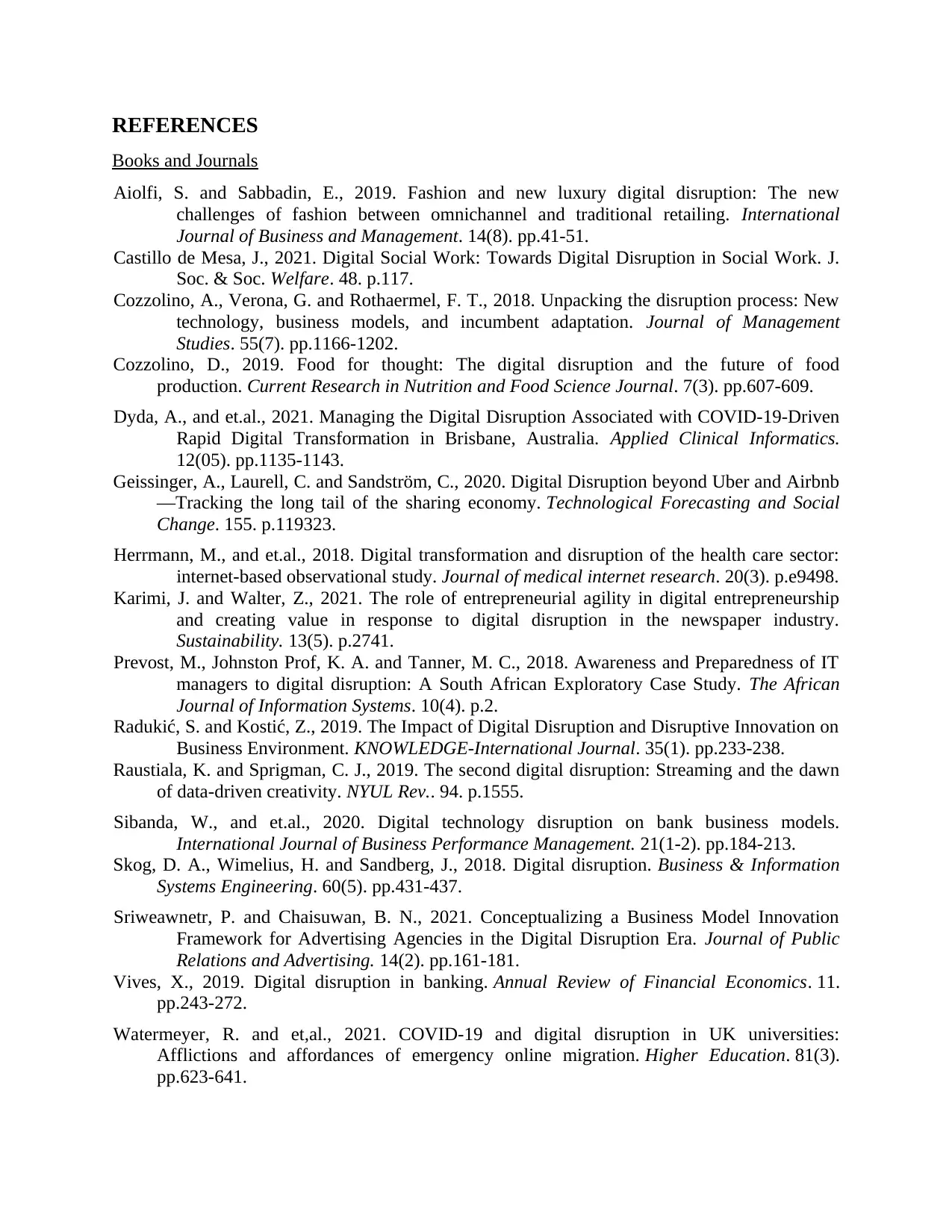
REFERENCES
Books and Journals
Aiolfi, S. and Sabbadin, E., 2019. Fashion and new luxury digital disruption: The new
challenges of fashion between omnichannel and traditional retailing. International
Journal of Business and Management. 14(8). pp.41-51.
Castillo de Mesa, J., 2021. Digital Social Work: Towards Digital Disruption in Social Work. J.
Soc. & Soc. Welfare. 48. p.117.
Cozzolino, A., Verona, G. and Rothaermel, F. T., 2018. Unpacking the disruption process: New
technology, business models, and incumbent adaptation. Journal of Management
Studies. 55(7). pp.1166-1202.
Cozzolino, D., 2019. Food for thought: The digital disruption and the future of food
production. Current Research in Nutrition and Food Science Journal. 7(3). pp.607-609.
Dyda, A., and et.al., 2021. Managing the Digital Disruption Associated with COVID-19-Driven
Rapid Digital Transformation in Brisbane, Australia. Applied Clinical Informatics.
12(05). pp.1135-1143.
Geissinger, A., Laurell, C. and Sandström, C., 2020. Digital Disruption beyond Uber and Airbnb
—Tracking the long tail of the sharing economy. Technological Forecasting and Social
Change. 155. p.119323.
Herrmann, M., and et.al., 2018. Digital transformation and disruption of the health care sector:
internet-based observational study. Journal of medical internet research. 20(3). p.e9498.
Karimi, J. and Walter, Z., 2021. The role of entrepreneurial agility in digital entrepreneurship
and creating value in response to digital disruption in the newspaper industry.
Sustainability. 13(5). p.2741.
Prevost, M., Johnston Prof, K. A. and Tanner, M. C., 2018. Awareness and Preparedness of IT
managers to digital disruption: A South African Exploratory Case Study. The African
Journal of Information Systems. 10(4). p.2.
Radukić, S. and Kostić, Z., 2019. The Impact of Digital Disruption and Disruptive Innovation on
Business Environment. KNOWLEDGE-International Journal. 35(1). pp.233-238.
Raustiala, K. and Sprigman, C. J., 2019. The second digital disruption: Streaming and the dawn
of data-driven creativity. NYUL Rev.. 94. p.1555.
Sibanda, W., and et.al., 2020. Digital technology disruption on bank business models.
International Journal of Business Performance Management. 21(1-2). pp.184-213.
Skog, D. A., Wimelius, H. and Sandberg, J., 2018. Digital disruption. Business & Information
Systems Engineering. 60(5). pp.431-437.
Sriweawnetr, P. and Chaisuwan, B. N., 2021. Conceptualizing a Business Model Innovation
Framework for Advertising Agencies in the Digital Disruption Era. Journal of Public
Relations and Advertising. 14(2). pp.161-181.
Vives, X., 2019. Digital disruption in banking. Annual Review of Financial Economics. 11.
pp.243-272.
Watermeyer, R. and et,al., 2021. COVID-19 and digital disruption in UK universities:
Afflictions and affordances of emergency online migration. Higher Education. 81(3).
pp.623-641.
Books and Journals
Aiolfi, S. and Sabbadin, E., 2019. Fashion and new luxury digital disruption: The new
challenges of fashion between omnichannel and traditional retailing. International
Journal of Business and Management. 14(8). pp.41-51.
Castillo de Mesa, J., 2021. Digital Social Work: Towards Digital Disruption in Social Work. J.
Soc. & Soc. Welfare. 48. p.117.
Cozzolino, A., Verona, G. and Rothaermel, F. T., 2018. Unpacking the disruption process: New
technology, business models, and incumbent adaptation. Journal of Management
Studies. 55(7). pp.1166-1202.
Cozzolino, D., 2019. Food for thought: The digital disruption and the future of food
production. Current Research in Nutrition and Food Science Journal. 7(3). pp.607-609.
Dyda, A., and et.al., 2021. Managing the Digital Disruption Associated with COVID-19-Driven
Rapid Digital Transformation in Brisbane, Australia. Applied Clinical Informatics.
12(05). pp.1135-1143.
Geissinger, A., Laurell, C. and Sandström, C., 2020. Digital Disruption beyond Uber and Airbnb
—Tracking the long tail of the sharing economy. Technological Forecasting and Social
Change. 155. p.119323.
Herrmann, M., and et.al., 2018. Digital transformation and disruption of the health care sector:
internet-based observational study. Journal of medical internet research. 20(3). p.e9498.
Karimi, J. and Walter, Z., 2021. The role of entrepreneurial agility in digital entrepreneurship
and creating value in response to digital disruption in the newspaper industry.
Sustainability. 13(5). p.2741.
Prevost, M., Johnston Prof, K. A. and Tanner, M. C., 2018. Awareness and Preparedness of IT
managers to digital disruption: A South African Exploratory Case Study. The African
Journal of Information Systems. 10(4). p.2.
Radukić, S. and Kostić, Z., 2019. The Impact of Digital Disruption and Disruptive Innovation on
Business Environment. KNOWLEDGE-International Journal. 35(1). pp.233-238.
Raustiala, K. and Sprigman, C. J., 2019. The second digital disruption: Streaming and the dawn
of data-driven creativity. NYUL Rev.. 94. p.1555.
Sibanda, W., and et.al., 2020. Digital technology disruption on bank business models.
International Journal of Business Performance Management. 21(1-2). pp.184-213.
Skog, D. A., Wimelius, H. and Sandberg, J., 2018. Digital disruption. Business & Information
Systems Engineering. 60(5). pp.431-437.
Sriweawnetr, P. and Chaisuwan, B. N., 2021. Conceptualizing a Business Model Innovation
Framework for Advertising Agencies in the Digital Disruption Era. Journal of Public
Relations and Advertising. 14(2). pp.161-181.
Vives, X., 2019. Digital disruption in banking. Annual Review of Financial Economics. 11.
pp.243-272.
Watermeyer, R. and et,al., 2021. COVID-19 and digital disruption in UK universities:
Afflictions and affordances of emergency online migration. Higher Education. 81(3).
pp.623-641.
⊘ This is a preview!⊘
Do you want full access?
Subscribe today to unlock all pages.

Trusted by 1+ million students worldwide
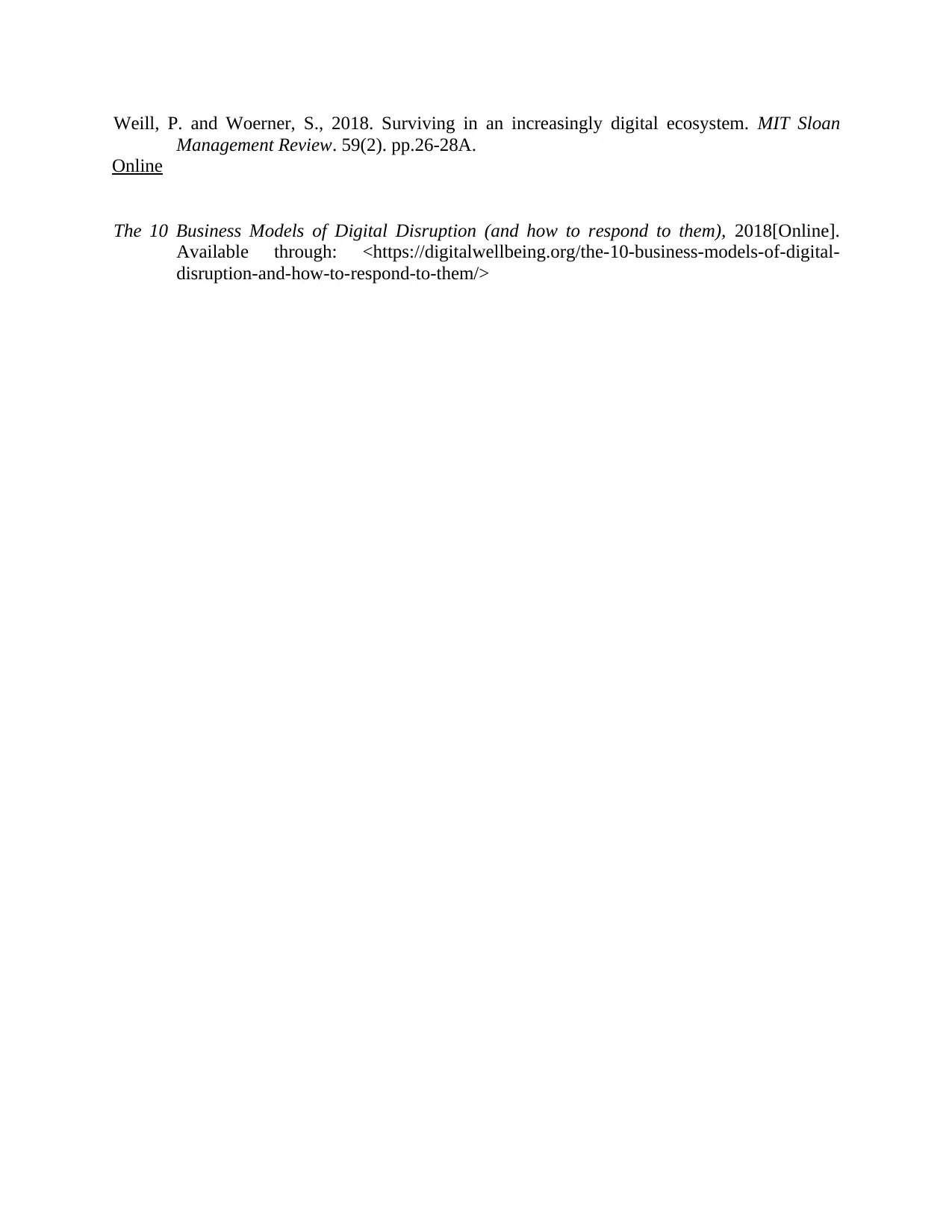
Weill, P. and Woerner, S., 2018. Surviving in an increasingly digital ecosystem. MIT Sloan
Management Review. 59(2). pp.26-28A.
Online
The 10 Business Models of Digital Disruption (and how to respond to them), 2018[Online].
Available through: <https://digitalwellbeing.org/the-10-business-models-of-digital-
disruption-and-how-to-respond-to-them/>
Management Review. 59(2). pp.26-28A.
Online
The 10 Business Models of Digital Disruption (and how to respond to them), 2018[Online].
Available through: <https://digitalwellbeing.org/the-10-business-models-of-digital-
disruption-and-how-to-respond-to-them/>
1 out of 10
Related Documents
Your All-in-One AI-Powered Toolkit for Academic Success.
+13062052269
info@desklib.com
Available 24*7 on WhatsApp / Email
![[object Object]](/_next/static/media/star-bottom.7253800d.svg)
Unlock your academic potential
Copyright © 2020–2025 A2Z Services. All Rights Reserved. Developed and managed by ZUCOL.




